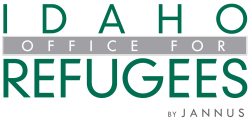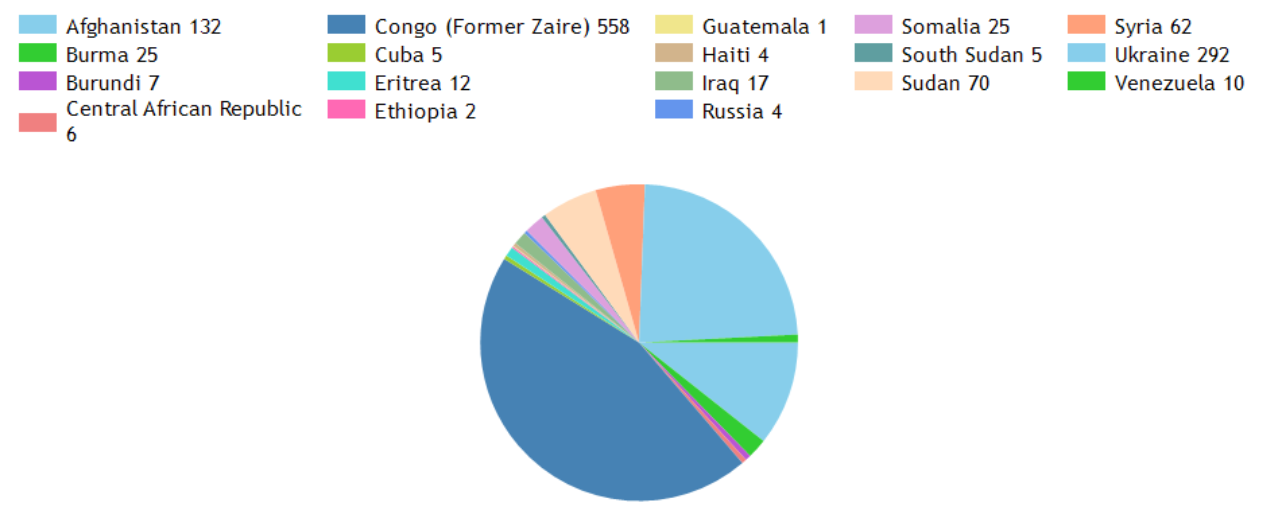About Refugees in Idaho
Idaho entered the refugee resettlement arena in 1975 when Governor John Evans established the Indochinese Refugee Assistance Program in response to the need for all states to participate in the resettlement of refugees fleeing the overthrow of U.S. supported governments in Southeast Asia. While the resettlement effort initially focused on refugees from Vietnam, Cambodia and Laos, it soon expanded in scope to include Eastern European refugees fleeing oppressive regimes of the Soviet era. Over the years, the refugee groups resettling in Idaho have changed and become remarkably diverse, but the essential resettlement experience has remained constant throughout.
Current Arrivals
- Idaho has welcomed just over 1,200 people in fiscal year 2023, on par with the previous year.
- Refugee arrivals are projected to be 1,050 in fiscal year 2024 - starting Oct. 1, 2024.
FY23 Arrivals by Countries of Origin:
Resettlement Agencies in Idaho:
- Agency for New Americans, Boise
- International Rescue Committee, Boise
- Ukrainian Welcome Center, Nampa
- College of Southern Idaho Refugee Programs, Twin Falls
Top Primary Languages of Arrivals, 2023
What is the Resettlement Experience?
The refugee’s journey is long, arduous and fraught with danger. The culmination of this journey—for those fortunate enough to complete it—is arrival in the community designated for resettlement. This is often a dramatic, emotional and life-changing event. Refugees and their families who are afforded the opportunity to begin a new life in Boise or Twin Falls find themselves in a safe and secure community where they begin a difficult adjustment process. Among the many challenges of becoming Americans are the need to develop new language and work skills, to find jobs that support their families and to manage newfound opportunity and freedom. Eventually, refugees become integrated into Idaho life, participating in and contributing to the social, economic, educational and political mosaic.
Who are Refugees in Idaho?
A large majority of refugees arriving in Idaho are women and children. Some refugees are highly educated while others have never had the opportunity to attend school. Some were freedom fighters or political activists forced into exile from their home countries; others were violently driven away because they were the “wrong” ethnicity or held religious beliefs that threatened those in power; and others have been targeted and subjected to horrific acts because of their ties to the U.S. government. Every refugee resettled in Idaho has a personal story of persecution, escape and survival.
1980s: Refugees arriving in Idaho during the decade of the 1980s were primarily Southeast Asian and Eastern European. Those coming from Vietnam, Laos and Cambodia were part of the ongoing exodus from the Communist domination of those countries. At the same time, refugees from Soviet-dominated Czechoslovakia, Poland, Hungary, Romania and Bulgaria were being resettled in increasing numbers. U.S. refugee policy in the 1980s was undeniable linked to vital foreign policy interests and the Cold War struggle between East and West. By the latter half of the 1980s, these groups were joined by an increasing number of refugees arriving from the Soviet Union, primarily Russians and Ukrainians, many of whom were evangelical Christians oppressed for many decades because of their religious convictions.
Groups from Southeast Asia
1990s: During the 1990s Idaho resettled over 5,000 refugees, more than half of which were from Bosnia and Herzegovina. Civil war, ethnic cleansing and unchecked violence forced millions of Bosnians to flee their homeland, and the subsequent impossibility of return for many led to a major resettlement effort by the U.S. The other half of the refugees arriving in the 1990s originated from other European countries, Africa, East Asia, the Near East, Central Asia and the Caribbean.
2000s: Idaho has resettled individuals from different countries between 2000 and 2017. While arrivals from these countries has grown and shrunk, recent arrivals include a large number of individuals from Iraq, Congo, Burma, Bhutan, Afghanistan, and Somalia.
The refugee’s journey is long, arduous and fraught with danger. The culmination of this journey—for those fortunate enough to complete it—is arrival in the community designated for resettlement. This is often a dramatic, emotional and life-changing event. Refugees and their families who are afforded the opportunity to begin a new life in Boise or Twin Falls find themselves in a safe and secure community where they begin a difficult adjustment process. Among the many challenges of becoming Americans are the need to develop new language and work skills, to find jobs that support their families and to manage newfound opportunity and freedom. Eventually, refugees become integrated into Idaho life, participating in and contributing to the social, economic, educational and political mosaic.
Who are Refugees in Idaho?
A large majority of refugees arriving in Idaho are women and children. Some refugees are highly educated while others have never had the opportunity to attend school. Some were freedom fighters or political activists forced into exile from their home countries; others were violently driven away because they were the “wrong” ethnicity or held religious beliefs that threatened those in power; and others have been targeted and subjected to horrific acts because of their ties to the U.S. government. Every refugee resettled in Idaho has a personal story of persecution, escape and survival.
1980s: Refugees arriving in Idaho during the decade of the 1980s were primarily Southeast Asian and Eastern European. Those coming from Vietnam, Laos and Cambodia were part of the ongoing exodus from the Communist domination of those countries. At the same time, refugees from Soviet-dominated Czechoslovakia, Poland, Hungary, Romania and Bulgaria were being resettled in increasing numbers. U.S. refugee policy in the 1980s was undeniable linked to vital foreign policy interests and the Cold War struggle between East and West. By the latter half of the 1980s, these groups were joined by an increasing number of refugees arriving from the Soviet Union, primarily Russians and Ukrainians, many of whom were evangelical Christians oppressed for many decades because of their religious convictions.
Groups from Southeast Asia
- Hundreds of thousands fleeing Vietnam by boat
- Amerasians
- Re-Education Camp Detainees
- Hmong and Lowland Lao
- Cambodians from the “Killing Fields”
- Political Dissidents
- Oppressed Workers (Solidarity Movement in Poland)
- Persecuted Christians and Jews from the Soviet Union
1990s: During the 1990s Idaho resettled over 5,000 refugees, more than half of which were from Bosnia and Herzegovina. Civil war, ethnic cleansing and unchecked violence forced millions of Bosnians to flee their homeland, and the subsequent impossibility of return for many led to a major resettlement effort by the U.S. The other half of the refugees arriving in the 1990s originated from other European countries, Africa, East Asia, the Near East, Central Asia and the Caribbean.
- Bosnian Muslims subjected to ethnic cleansing and genocide
- Croatian Serbs caught up in border conflicts and territorial disputes
- Roma who were caught in the conflict ensuing from the breakup of Yugoslavia
- Ethnic Albanians from Kosovo
2000s: Idaho has resettled individuals from different countries between 2000 and 2017. While arrivals from these countries has grown and shrunk, recent arrivals include a large number of individuals from Iraq, Congo, Burma, Bhutan, Afghanistan, and Somalia.
Arrival Trends in Idaho
Idaho Office for refugees |
|


